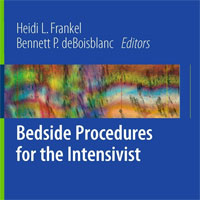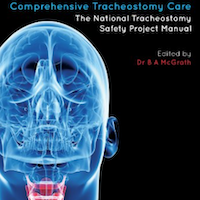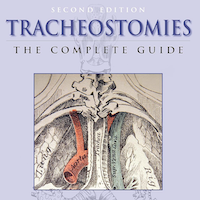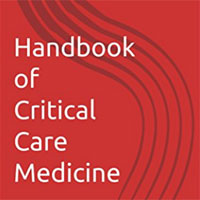Tag: tracheostomy
Successful Clearance of Persistent Staphylococcus Aureus Pneumonia Using High-dose Continuous Infusion Cefazolin
High-dose cefazolin (10 g daily), given as a continuous infusion (CI), was able to clear community-acquired methicillin-susceptible Staphylococcus aureus (MSSA) pneumonia while not exhibiting any signs of toxicity or adverse... read more
Bedside Procedures for the Intensivist
Bedside Procedures for the Intensivist delivers practical tips and clear, step-by-step instruction on the most common procedures in the ICU. The convenient and portable handbook focuses on ultrasound-guided techniques, including... read more

Accurate Percutaneous Tracheal Tube Placement Using Visual-Guided Transillumination Method
The novel Illuminated Tracheal Alignment Guide (iTAG) device and technique is the first of our knowledge to test the identification of tracheostomy sites by way of laser-guided transillumination. We believe this device... read more
Flow Control Ventilation in ICU
Flow control ventilation is an innovative technique of mechanical ventilation with a potentially lung protective characteristics. The constant inspiratory and expiratory flow, no ventilation pauses, and inspiration to... read more
Tracheostomy in COVID-19 Patients
Tracheostomy is common in critically ill COVID-19 patients. In patients predicted to need a tracheostomy at some point, early, rather than late, tracheostomy might be a means to reduce the time spent in ICU. However,... read more
Single Lumen vs. Double Lumen Endotracheal Tube For Postoperative Swallowing Function in Lung Transplantation Patients
BackgroundThis study was conducted to investigate the effect of endotracheal tube type on post operative dysphagia in patients undergoing lung transplant surgery. Will patients who are intubated with a single lumen endotracheal... read more
Implementing Bedside Percutaneous Tracheostomy and PUG Team to Reduce LOS
Thousands of critically ill patients every year in the United States receive tracheostomy and gastrostomy procedures. Recent research has investigated the benefits of a combined team approach to these procedures, with associated... read more
Early Tracheostomy in Ventilated COVID-19 Patients Reduces VAP Incidence
Tracheostomy can reduce mechanical ventilation (MV) duration, ICU and hospital length of stay (LOS), and ventilator-associated pneumonia (VAP) risk in critically ill patients. The timing of tracheostomy in COVID-19 patients... read more
Implementing a Bedside Percutaneous Tracheostomy and Ultrasound Gastrostomy Team Reduces Length of Stay and Hospital Costs
Thousands of critically ill patients every year in the United States receive tracheostomy and gastrostomy procedures. Recent research has investigated the benefits of a combined team approach to these procedures, with associated... read more
Comprehensive Tracheostomy Care: The National Tracheostomy Safety Project Manual (Advanced Life Support Group)
Comprehensive Tracheostomy Care is a resource developed by the UK National Tracheostomy Safety Project (NTSP) to help promote and facilitate the safe management of tracheostomies and laryngectomies. The scope includes... read more

Tracheostomies The Complete Guide
Tracheostomies: The Complete Guide (2nd ed.) serves as a comprehensive resource for healthcare practitioners and patients navigating the complexities of tracheostomy and laryngectomy care. This edition emphasizes the... read more

Predictive Value of Diaphragm and Lung Ultrasonography for Weaning Failure in Critically Ill Patients with ARF Due to COVID-19 Pneumonia
Patients undergoing mechanical ventilation due to respiratory failure require a comprehensive approach to determine the optimal timing for weaning from ventilatory support. Evaluating respiratory mechanics, maximal muscle... read more
Sex Differences in the Outcome of Critically Ill COVID-19 Patients
Among patients admitted to ICU for severe COVID-19, males experienced higher severity of illness and more frequent intervention than females. Ultimately, the hazard of death was moderately elevated in males compared to females... read more
Influenza and COVID-19 Vaccination Rates Among Children Receiving Long-Term Ventilation
Children with tracheostomy and HV are at high risk of morbidity and mortality from viral ARIs. Among MyTRaCh enrollees, we found significant discrepancy between influenza and COVID-19 vaccination status. Compared with... read more
Device Associated Complications in the ICU
Although mortality in the intensive care unit (ICU) has declined over time, ICU associated complications remain common, affecting up to a half of critically ill patients and resulting in increased mortality, longer hospital... read more
Ineffective Airway Clearance Nursing Diagnosis & Care Plans
Ineffective airway clearance is the inability to clear secretions or obstructions from the respiratory tract. This can be detrimental to breathing and create complications. Secretions can be problematic as a result of... read more
Plasma Hyaluronan, Hyaluronidase Activity and Endogenous Hyaluronidase Inhibition in Sepsis
Elevated plasma hyaluronan levels coincided with a concomitant decrease in effective plasma HYAL activity and increase of endogenous plasma HYAL inhibition both in experimental and clinical sepsis. In acute pancreatitis,... read more
To Bronch or Not to Bronch – That Is the Question
Percutaneous tracheostomy was safely and effectively performed by an experienced surgical team both with and without bronchoscopic guidance with no difference in the complication rates. This study suggests that the use... read more
Percutaneous Dilational Tracheostomy for COVID-19 Patients Requiring Mechanical Ventilation
Patients with COVID-19 who survive the early days of MV experience severe and prolonged respiratory failure. An early modified percutaneous dilational tracheostomy (PDT) was safe for patients and healthcare providers and... read more
Association of Low Baseline Diaphragm Muscle Mass With Prolonged Mechanical Ventilation and Mortality Among Critically Ill Adults
In this study, low baseline diaphragm muscle mass in critically ill patients was associated with prolonged mechanical ventilation, complications of acute respiratory failure, and an increased risk of death in the hospital. A... read more
Ventilator Weaning and Discontinuation Practices for Critically Ill Patients
In this observational study of invasive mechanical ventilation discontinuation in 142 ICUs in Canada, India, the UK, Europe, Australia/New Zealand, and the US from 2013 to 2016, weaning practices varied internationally. Among... read more
Early Intervention for the Treatment of Acute Laryngeal Injury After Intubation
This study suggests that early intervention for patients with postintubation laryngeal injury was associated with a decreased duration of tracheostomy dependence, a higher rate of decannulation, and fewer surgical procedures... read more









